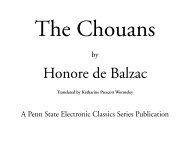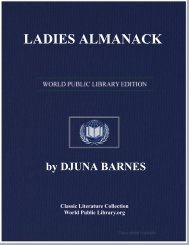THE GOD OF THE WITCHES - World eBook Library - World Public ...
THE GOD OF THE WITCHES - World eBook Library - World Public ...
THE GOD OF THE WITCHES - World eBook Library - World Public ...
Create successful ePaper yourself
Turn your PDF publications into a flip-book with our unique Google optimized e-Paper software.
covens of the Horned God took their rise before the introduction of Christianity into the world.<br />
There is only one trial in which the number thirteen is specifically mentioned, when Isobel Gowdie, stated that in<br />
each coven of her district there were thirteen persons. In the other trials the number is indicated and can be<br />
recovered by counting up the accused persons. As I have noted above, the Old Religion held its place longer<br />
among the women than among the men. The coven of Romulus consisted of thirteen men; if the legendary<br />
companions of Robin Hood[8] were real personages, then that coven was composed of twelve men and one<br />
woman; Gilles de Rais (1440)[9] had eleven men and two women, Bessie Dunlop (1567)[10] spoke of five men<br />
and eight women, and in Kinross-shire (1662)[11] one man and twelve women formed the coven.<br />
The Incarnate God, called the Devil by the Christian recorders, was the supreme chief of the coven; the second<br />
in command was known as the Officer, who represented the Chief in his absence, and there was besides a<br />
woman-member called in Scotland the "Maiden".[12] All offices could be held by women, including that of Chief,<br />
though they were usually filled by men, except of course that of the Maiden, who was always a woman. In<br />
England women appear to have sometimes doubled the offices of deputy-chief and of Maiden. Wherever she is<br />
recorded the Maiden appears as a more important person than the officer and as ranking next to the<br />
Grandmaster though without executive power. She sat at the right hand of the Incarnate God at feasts, and she<br />
generally led the dance with him. If, as I maintain, Joan of Arc belonged to the Old Religion her title of La<br />
Pucelle, the Maid, takes a new significance and emphasises her position in regard to her royal master, for she<br />
was not only Maid of Orleans but bore the higher title of La Pucelle de France.<br />
To any member of the coven might be deputed the task of summoner. In a small district the Chief himself would<br />
notify all members as to the place where the Esbat or weekly meeting would be held; but in a large district a<br />
member, well known to the whole coven, went from house to house with the information. "Many times himself<br />
warneth them to meet, sometimes he appointeth others to warn them in his stead",[13] as was the case with<br />
Robert Grieve of Lauder in 1649, "the Devil gave him that charge, to be his officer to warn all to the<br />
meetings".[14] The summoner, whether Chief or ordinary member, was careful to be inconspicuous when<br />
employed in this way. In Renfrewshire this secrecy was carried further than usual, "for particular warning there<br />
appeared a Black Dog with a Chain about his Neck, who tinkling it, they were to follow".[15]<br />
The duties of the officer were varied; he was often the summoner, he arranged for the meetings and saw that<br />
due notice was given, he kept the records of attendance and of work done, he presented new members and<br />
informed the Chief of any likely convert. If the Chief did not choose to dance the officer led the ring and if the<br />
officer were also a Christian priest, as was not uncommon, he performed part of the religious service.<br />
The musician was another important member of coven. The Chief was often the performer, sitting in the centre<br />
of the ring and playing on the pipes, the flute or the Jews' harp. Jonet Lucas of Aberdeen 16 in 1597 was<br />
accused that "thou and they was under the conduct of thy master the Devil, dancing in a ring, and he playing<br />
melodiously upon an instrument". On another occasion Isobel Cockie of the same coven did not approve of the<br />
Devil's playing, "thou wast the ringleader, next Thomas Leyis, and because the Devil played not so melodiously<br />
and well as thou crewit, thou took the instrument out of his mouth, then took him on the chaps therewith and<br />
played thyself thereon to the whole company". As a rule, however, the musician did not dance the round dance<br />
but sat outside the ring (plate X), though in the long dance he was often the leader.<br />
The organisation was very complete, each coven being independent under its own officer, yet linked with all the<br />
other covens of the district under one Grandmaster. This was the system, which in all probability was followed by<br />
Augustine when he "placed bishops in every place where there had been flamens, and archbishops where there<br />
had been arch-flamens".<br />
A coven could act alone or, when numbers were needed, could combine with others. For a combined effort the<br />
witches of North Berwick afford one of the best examples.[17] There were thirty-nine men and women, i.e. three<br />
covens, who met together to aid their Master in destroying James VI of Scotland. Some raised the storm, some<br />
undertook the slow destruction of the wax image, some prepared the toad poison, and some arranged to get a<br />
garment which the King had worn. These duties were more than the members of one coven could manage, and<br />
24















